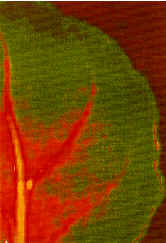X-RAY RUNS: Apply for Beamtime
2017 Nov 1 - Dec 21
2018 Feb 7 - Apr 3
2018 Proposal/BTR deadline: 12/1/17
2018 Apr 11 - Jun 4
2018 Proposal/BTR deadline: 2/1/18
M. Lasat1, L. Kochian1, M. Toaspern2, K.W.
Smolenski2, K. Finkelstein2, E. Fontes2, D. Bilderback2
1USDA-ARS Plant, Soil and Nutrition Laboratory, Cornell University
2CHESS, Cornell University
The existence of plant species that can accumulate very high levels of
heavy metals suggests that the genetic potential exists to use
terrestrial plants to clean surface soils contaminated with toxic
metals. One of the best known heavy metal hyperaccumulators is Thlaspi
caerulescens, a member of the cabbage family which has been shown to
accumulate up to 3% Zn on a dry weight basis in without showing toxicity
symptoms. X-ray fluorescence and absorbance spectroscopy (XANES)
measurements at CHESS have been used investigate Zn hyperaccumulation in
T. caerulescens.


Zn fluorescence images of a T. caerulescens leaf from (left): a plant grown for forty days on 1 : M Zn2+ and
then grown for the last 10 days in a nutrient solution without Zn
and (right): a plant grown for forty days on 1 M Zn and then grown
for the last 10 days in a nutrient solution supplemented with 150 M
Zn2+. The scale of pseudo-color images relating relative Zn
concentration to color is:
yellow (highest) > red > green > brown (least).
Shown in the x-ray fluorescence images above, the pattern of Zn
accumulation in leaves was different in leaves of T. caerulescens
compared with a related nonaccumulator species. For plants grown on
a range of Zn concentrations, very little Zn fluorescence was
emitted from leaves of the nonaccumulator species and this signal
was associated exclusively with the leaf vascular tissue. In the Zn-hyperaccumulator
T. caerulescens, the pattern of Zn accumulation was dependent upon
the amount of Zn stored in the leaves. After growth on low Zn
levels, most of the Zn was localized in the vascular tissue. As Zn
accumulation in leaves increased, Zn fluorescence increased from
leaf tissue between the veins, indicating that the excess Zn is a
stored inside living leaf cells.
These results are important because they suggest that Zn
hyperaccumulation in T. caerulescens involves alterations in Zn
transport systems and chemical speciation in leaves. Studies have
been initiated to characterize the chemical environment associated
with Zn accumulation in leaf cells and thereby determine what
organic ligands might be complexed with Zn.
